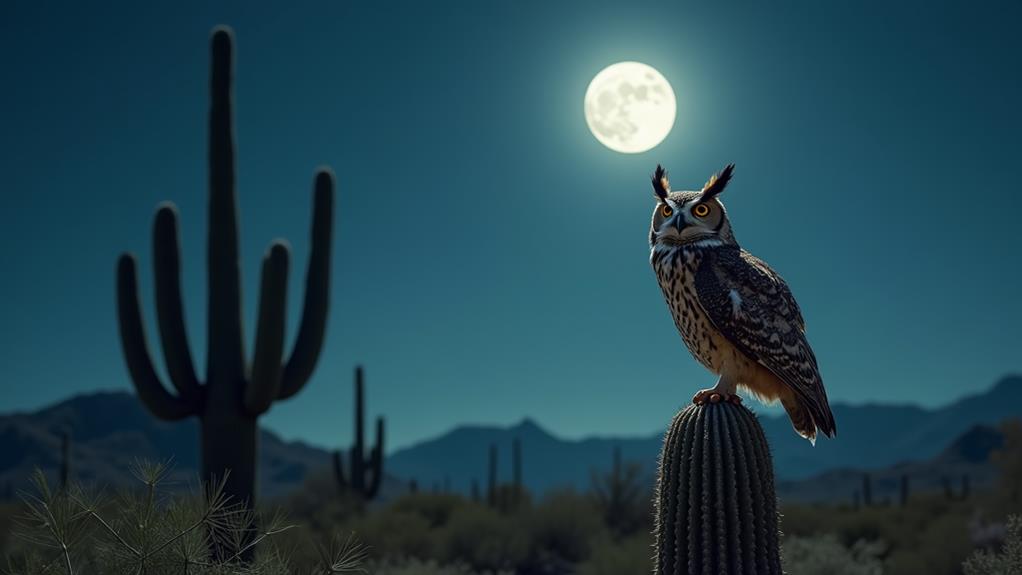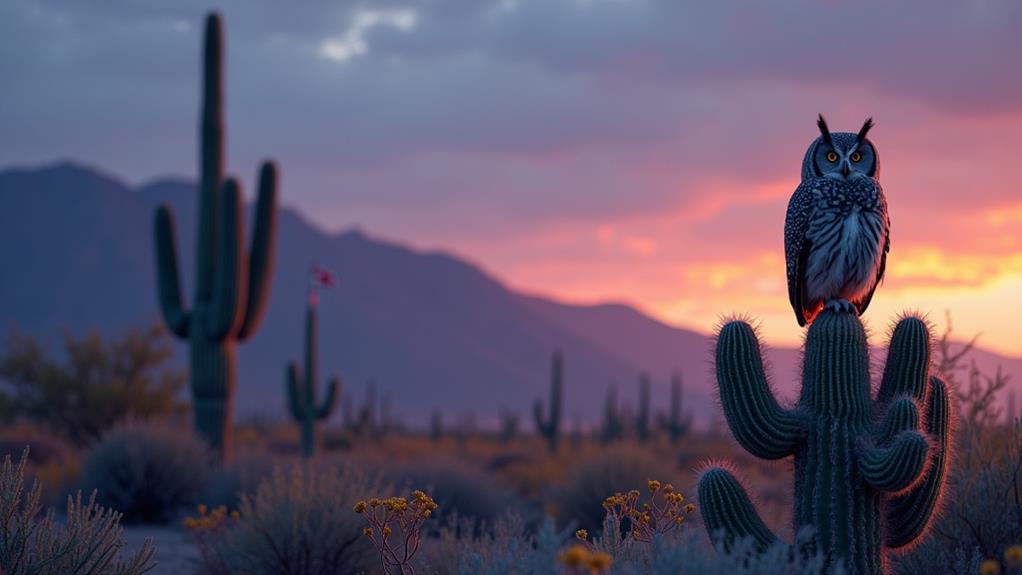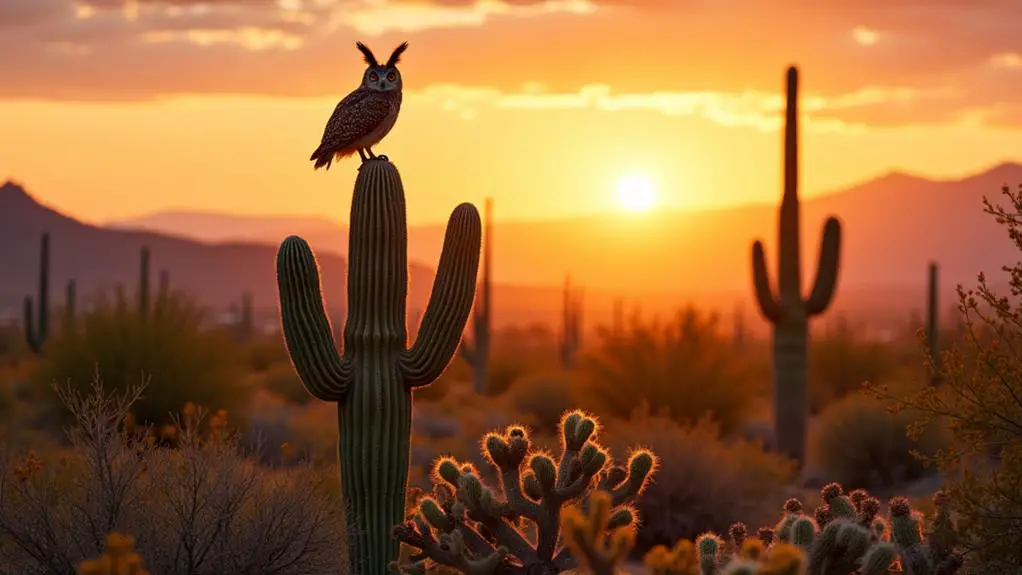You find yourself in the midst of a real-life fairy tale when surrounded by the majestic landscapes of Arizona, where the creatures of the night take center stage. The Grand Canyon State is home to a diverse array of owl species, each with its unique characteristics and adaptations that have evolved to thrive in this remarkable environment. As you venture into the heart of Arizona’s wilderness, you’ll catch glimpses of these enigmatic birds, Owls of Arizona, their piercing gazes and soft hooting calls leaving you wondering what secrets they might be hiding.
Key Takeaways
- Arizona’s diverse landscape supports a remarkable array of owl species, making it a nature lover’s delight.
- Unique owl habitats in Arizona, such as the Patagonia-Sonoita Creek Sanctuary, offer a chance to observe owls in their natural environments.
- Owls’ specialized physical characteristics, such as facial disk feathers and silent wing patterns, enable them to thrive in Arizona’s wilderness.
- Arizona owls’ exceptional hearing abilities and hunting strategies, including silent wing approaches, make them expert hunters.
- Conservation efforts in Arizona, including habitat restoration and land management practices, help ensure the long-term sustainability of owl populations.
Arizona’s Owl Diversity Hotspots

Arizona’s diverse landscape, comprising desert grasslands, mountainous regions, and riparian corridors, frequently supports a remarkable array of owl species.
As you explore the state, you’ll find that certain regions stand out as owl diversity hotspots. These areas often feature unique combinations of owl habitats, including forests, grasslands, and wetlands, which provide essential resources for owls to survive and thrive.
Some of the most notable owl diversity hotspots in Arizona include the Patagonia-Sonoita Creek Sanctuary, the San Bernardino National Wildlife Refuge, and the Tonto National Forest.
These bird sanctuaries provide critical habitat for various owl species, including the Western Screech-Owl, the Great Horned Owl, and the Burrowing Owl. By visiting these areas, you’ll have a unique opportunity to observe these fascinating birds in their natural habitats.
Remember to respect these sensitive ecosystems and follow guidelines for responsible birdwatching to ensure the long-term conservation of Arizona’s owl populations.
Unique Characteristics of Arizona Owls
As you delve into the world of Arizona’s owls, you’ll discover that each species boasts a distinct set of characteristics that have evolved to thrive in this unique environment.
These adaptations are crucial for their survival, and they’re a testament to the remarkable diversity of owl species in Arizona.
Some of the unique characteristics of Arizona owls include:
- Facial disk feathers: These specialized feathers around their faces help funnel sound towards their ears, allowing them to pinpoint prey in the dark.
- Wing patterns: The intricate patterns on their wings, such as spots or stripes, serve as camouflage, helping them blend in with their surroundings.
- Acute hearing: Arizona owls have extremely sensitive hearing, which enables them to detect the faint sounds of potential prey, even in complete darkness.
- Specialized talons: Their powerful, sharp talons are designed for grasping and killing prey, making them expert hunters in the Arizona wilderness.
These remarkable adaptations have allowed Arizona owls to flourish in their environment, making them a fascinating subject for nature enthusiasts and scientists alike.
Desert Dwellers of the Night

You’re about to venture into the realm of Arizona’s nocturnal desert dwellers, where the owls reign supreme.
As you explore the arid landscape under the cover of darkness, you’ll discover that these birds have adapted remarkably to their environment.
The desert-dwelling owls of Arizona have evolved to thrive in the harsh conditions, with specialized features that enable them to hunt and survive in the dark.
One notable characteristic of these owls is their affinity for moonlit roosts.
They often perch on tree branches or rocky outcrops, where the soft, silvery light of the moon illuminates their dark silhouettes.
This allows them to rest while still maintaining a vigilant watch for potential predators.
Their exceptional night vision, facilitated by large, round eyes and highly sensitive retinas, enables them to detect even the slightest movements in their surroundings.
As you observe these desert dwellers, you’ll appreciate the intricate balance between their unique characteristics and the unforgiving environment they call home.
Forest Floor Feathered Friends
As you venture into Arizona’s forests, you’ll find a unique set of nocturnal owl species thriving on the forest floor.
These forest-dwelling birds have adapted to the darkness, using their acute hearing and exceptional night vision to hunt silently and efficiently.
Within the shelter of the trees, their wise eyes watch and wait, taking advantage of the forest’s cover to stalk their prey undetected.
Forest Dwelling Nocturnals Thrive
Several species of owls in Arizona thrive in the forest floor habitat, where the dense canopy above and the underbrush below provide them with an ideal environment for hunting and roosting.
As you explore this habitat, you’ll notice that these owls have adapted to life in the shadows. They’re expert Moonlight Roamers, using the faint illumination to navigate and hunt.
- The rustling of leaves beneath their silent wings is the only sound that betrays their presence, as they swoop down to catch unsuspecting rodents.
- The dappled light filtering through the trees creates a mosaic of shadows, allowing these Shadow Dwellers to blend in seamlessly.
- The scent of damp earth and decaying leaves fills the air, a reminder of the forest’s complex ecosystem and the owls’ role within it.
- The hooting calls of these nocturnal birds echo through the forest, a haunting melody that underscores their dominance in this domain.
In this environment, the owls’ unique characteristics – their acute hearing, exceptional night vision, and silent flight – give them a distinct advantage.
As a result, they’re able to thrive in this forest habitat, where other birds might struggle to survive.
Silent Hunters of Darkness
Forest floor dwellers, like the whiskered owlet and the flammulated owl, have evolved into Silent Hunters of Darkness, capitalizing on the forest’s nocturnal ambiance to outmaneuver their prey.
You’ll find these birds have adapted to the dark secrets of the forest floor, where the cover of darkness allows them to stalk their quarry undetected. Their exceptional hearing and acute vision enable them to pinpoint the slightest movements, even in the absence of light.
The nocturnal mystique of these owls lies in their ability to navigate through the darkness with ease, using the forest’s acoustic landscape to their advantage.
As you explore the Arizona forests, you’ll discover that these Silent Hunters of Darkness have honed their skills to perfection, making them the apex predators of the night.
Their stealthy movements and silent wingbeats allow them to swoop in on unsuspecting rodents, snakes, and other small creatures, making them the masters of the dark domain.
Trees Shelter Wise Eyes
While navigating Arizona’s forest floors, you’ll often find trees providing shelter for a distinct group of owls, aptly referred to as Forest Floor Feathered Friends.
These owls have adapted to life under the Tree Canopies, where the dense foliage offers protection from harsh weather conditions and predators.
As Shade Seekers, they thrive in the dimly lit environment, relying on their exceptional hearing and vision to hunt and navigate.
- The rustling of leaves beneath their silent wings signals the presence of a Western Screech-owl, expertly camouflaged in the underbrush.
- The trunks of trees serve as perches for Whiskered Owlets, their large, round eyes scanning the forest floor for unsuspecting prey.
- The hollows of ancient trees become cozy nesting sites for Burrowing Owls, sheltered from the elements and potential threats.
- The dappled shade created by the tree canopies above provides the perfect backdrop for owls to blend in, making them nearly invisible to the human eye.
Mysterious Migration Patterns

Across Arizona’s diverse landscapes, you’ll find various owl species exhibiting intriguing migration patterns, which scientists are still working to fully understand.
These patterns are complex and varied, with some species making altitudinal migrations, while others undertake latitudinal movements.
For instance, the Flammulated Owl, a common Arizona resident, migrates from its breeding grounds in the mountains to lower elevations during winter. This movement is thought to be triggered by the fading sunlight and decreasing temperatures, which limit their food supply.
As moonlit wanderers, owls are well adapted to nocturnal migration, using celestial cues to navigate. However, the exact mechanisms behind their migration patterns remain unclear.
Researchers have found that some owl species use visual and auditory cues, such as topography and bird calls, to guide their movements. Others may rely on innate magnetic fields or even the Earth’s gravitational field to orient themselves.
Despite ongoing research, the intricacies of owl migration patterns remain a fascinating enigma, waiting to be unraveled. By studying these patterns, scientists can gain a deeper understanding of the ecological and evolutionary pressures shaping these remarkable birds.
Hunting Strategies of Arizona Owls
As you observe Arizona owls in their natural habitat, you’ll notice they employ a unique silent wing approach, allowing them to sneak up on prey undetected.
This stealthy tactic is made possible by the specialized structure of their feathers, which enables them to fly silently.
Additionally, their acute hearing ability allows them to pinpoint the slightest sounds, making them highly effective hunters in the dark Arizona night.
Silent Wing Approach
Perching in the shadows, Arizona owls wait for the perfect moment to strike, employing their signature Silent Wing Approach to catch prey off guard.
This unique hunting strategy allows them to fly undetected, thanks to specialized wing anatomy and flight techniques.
You’ll notice how their wings are specially adapted with a serrated leading edge, allowing for a quieter takeoff and landing.
- The soft, fringed feathers on their wings reduce noise and air resistance, enabling them to fly stealthily.
- Their specially designed primary feathers have a stiff leading edge, which helps to reduce wing noise during flight.
- As they fly, Arizona owls use a slow, deliberate wingbeat to minimize sound waves.
- Their wing shape and angle of attack also play a crucial role in reducing turbulence and noise, making it nearly impossible for prey to detect them.
Acute Hearing Ability
Your ears are tuned to the faintest rustle of leaves, the softest scurry of tiny feet. This is what it’s like to experience the acute hearing ability of Arizona owls.
Their ears are specially structured to detect the faintest sounds, allowing them to pinpoint prey with ease. The ears’ asymmetrical structure, with one ear higher than the other, enables them to pinpoint sound sources with precision.
This unique feature, combined with their ability to rotate their heads 270 degrees, gives them an unparalleled range of sound detection.
As you observe an owl’s ears, you’ll notice the intricate details that enhance their hearing abilities.
The ear opening is surrounded by feathers, which help to funnel sound waves towards the eardrum. The eardrum itself is extremely sensitive, capable of detecting vibrations in the air.
This sensitivity allows owls to pick up on the slightest movements, even in complete darkness. By leveraging their acute hearing ability, Arizona owls can locate and capture prey with remarkable efficiency, making them one of the most effective predators in the desert landscape.
Owl Calls and Communication

Silence is a rare commodity in the Arizona wilderness, especially when owls are nearby.
As you venture into their territory, you’re likely to be treated to a symphony of vocalizations, each one a unique form of communication. Owls use a range of calls to convey vital information, from warning other owls of potential threats to attracting a mate.
- You might hear the haunting, mournful hoot of a Great Horned Owl, its low-pitched call carrying far and wide through the desert night air.
- The high-pitched whinny of a Western Screech-Owl might pierce the darkness, a staccato burst of sound that’s hard to miss.
- A Barn Owl’s screeching cry, often described as a blood-curdling scream, can send shivers down your spine.
- The soft, melodic hooting of a Flammulated Owl provides a soothing counterpoint to the more jarring sounds of its cousins.
These vocalizations are a testament to the owls’ remarkable acoustic adaptation, honed over thousands of years to navigate their environment.
Nesting and Breeding Habits
As dusk settles over the Arizona landscape, owls begin their nocturnal rituals, and their breeding habits take center stage.
You’ll notice that owls are monogamous, with pairs forming during the breeding season. The female owl takes charge of incubation, while the male provides food and protection.
During this time, you’ll observe owl parenting in action.
The female owl will lay 2-4 eggs, depending on the species, and incubate them for approximately 30 days.
After hatching, the young owlets will rely on their parents for food and protection. The male owl will bring prey to the nesting site, and the female will tear it into smaller pieces for the owlets to eat.
As you observe the nesting habits of Arizona’s owls, you’ll notice that nesting success is crucial for the survival of the species.
The nesting site, often a tree cavity or abandoned nest, provides protection from predators and harsh weather conditions.
You’ll see that the female owl will fiercely defend her nest and young, making nesting success a critical component of an owl’s life cycle.
Conservation Efforts in Arizona

While observing the nesting habits of Arizona’s owls, you may have noticed the importance of a safe and healthy environment for their survival.
Conservation efforts in Arizona are crucial to ensure the long-term sustainability of owl populations.
To achieve this, wildlife preserves and habitat restoration projects are underway.
These initiatives involve:
- Protecting and expanding natural habitats, such as forests and grasslands, to provide owls with undisturbed breeding and foraging grounds.
- Restoring degraded habitats by replanting native vegetation and removing invasive species.
- Collaborating with landowners and local communities to promote owl-friendly land management practices.
- Monitoring owl populations and habitats to identify areas that require conservation attention.
FAQs:Owls of Arizona
Can I Keep an Owl as a Pet in Arizona?
You can’t keep most owl species as pets in Arizona due to strict pet restrictions; only certain species, like barn owls, are permitted with special permits, and even then, you’ll need to meet rigorous owl ownership requirements.
Are Owls in Arizona Protected by Law?
You’ll find that owls in Arizona are indeed protected by law, thanks to wildlife conservation efforts focusing on habitat preservation, which safeguard these birds and their ecosystems from human activities that could harm or destroy them.
How Do I Attract Owls to My Backyard?
You can attract owls to your backyard by creating owl habitats, installing birdhouses with specific dimensions, and maintaining a rodent-rich environment, as owls are drawn to areas with abundant prey, dark nesting sites, and minimal human disturbance.
Can I Feed Owls in the Wild?
When considering wild feeding, you should refrain from feeding owls in the wild, as it can disrupt their natural habits and create dependence; instead, practice responsible birding by respecting their space and appreciating them from a distance.
Are Owl Tours Available in Arizona?
You’ll be intrigued to know that Arizona is home to over 20 owl species, and yes, you can embark on guided owl tours, offering moonlit excursions to spot these desert dwellers in their natural habitats, providing an unforgettable experience.
Conclusion
As you delve into the world of Arizona’s owls, you’ll discover a realm where the ordinary becomes extraordinary. With a staggering array of species, each with unique adaptations, you’ll be spoiled for choice. From the desert dwellers to the forest floor friends, every encounter will leave you awestruck. It’s as if Arizona’s owls hold the secrets of the night, and you’re privileged to be a part of their mystique. With every hoot, every silent wingbeat, you’ll be hooked – and your appreciation for these nocturnal wonders will soar to infinite heights.













